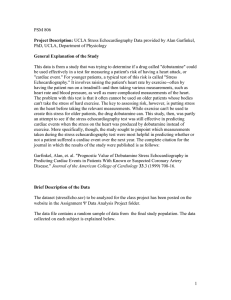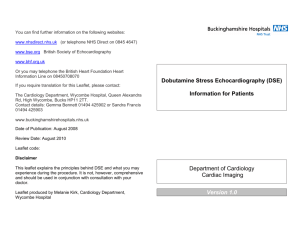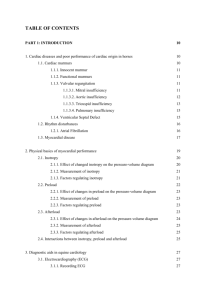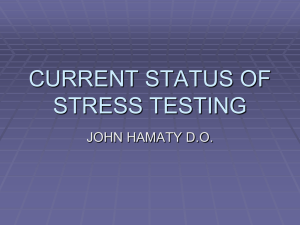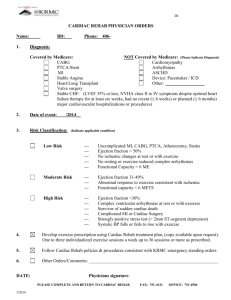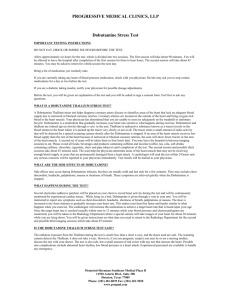Cardiac Data
advertisement
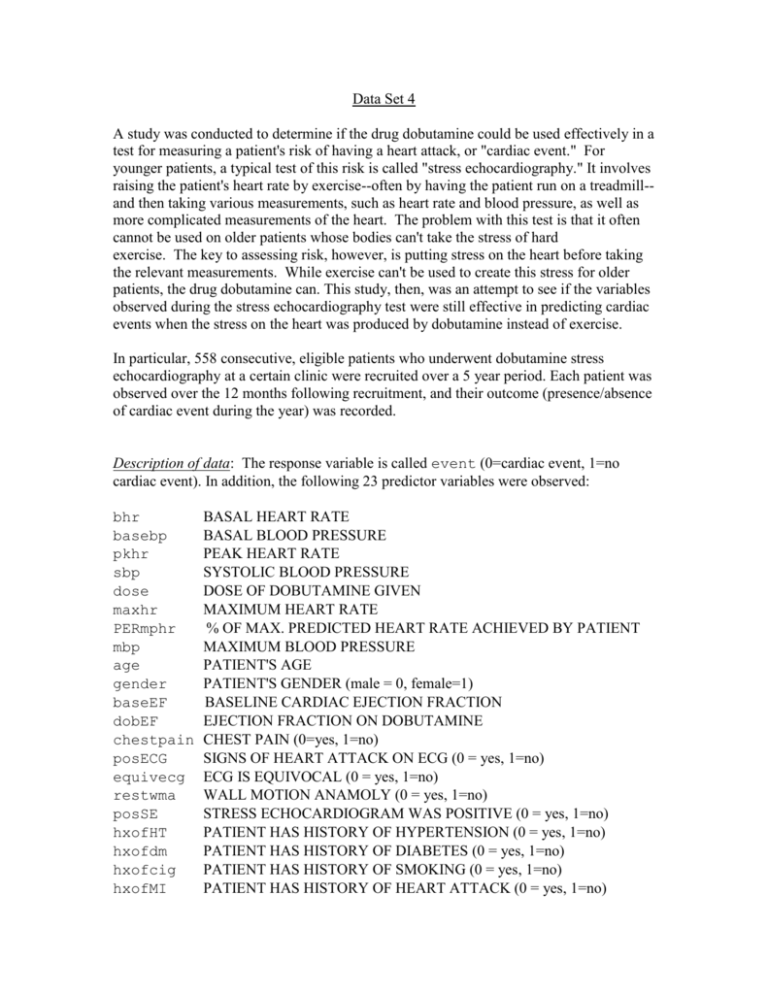
Data Set 4 A study was conducted to determine if the drug dobutamine could be used effectively in a test for measuring a patient's risk of having a heart attack, or "cardiac event." For younger patients, a typical test of this risk is called "stress echocardiography." It involves raising the patient's heart rate by exercise--often by having the patient run on a treadmill-and then taking various measurements, such as heart rate and blood pressure, as well as more complicated measurements of the heart. The problem with this test is that it often cannot be used on older patients whose bodies can't take the stress of hard exercise. The key to assessing risk, however, is putting stress on the heart before taking the relevant measurements. While exercise can't be used to create this stress for older patients, the drug dobutamine can. This study, then, was an attempt to see if the variables observed during the stress echocardiography test were still effective in predicting cardiac events when the stress on the heart was produced by dobutamine instead of exercise. In particular, 558 consecutive, eligible patients who underwent dobutamine stress echocardiography at a certain clinic were recruited over a 5 year period. Each patient was observed over the 12 months following recruitment, and their outcome (presence/absence of cardiac event during the year) was recorded. Description of data: The response variable is called event (0=cardiac event, 1=no cardiac event). In addition, the following 23 predictor variables were observed: bhr basebp pkhr sbp dose maxhr PERmphr mbp age gender baseEF dobEF chestpain posECG equivecg restwma posSE hxofHT hxofdm hxofcig hxofMI BASAL HEART RATE BASAL BLOOD PRESSURE PEAK HEART RATE SYSTOLIC BLOOD PRESSURE DOSE OF DOBUTAMINE GIVEN MAXIMUM HEART RATE % OF MAX. PREDICTED HEART RATE ACHIEVED BY PATIENT MAXIMUM BLOOD PRESSURE PATIENT'S AGE PATIENT'S GENDER (male = 0, female=1) BASELINE CARDIAC EJECTION FRACTION EJECTION FRACTION ON DOBUTAMINE CHEST PAIN (0=yes, 1=no) SIGNS OF HEART ATTACK ON ECG (0 = yes, 1=no) ECG IS EQUIVOCAL (0 = yes, 1=no) WALL MOTION ANAMOLY (0 = yes, 1=no) STRESS ECHOCARDIOGRAM WAS POSITIVE (0 = yes, 1=no) PATIENT HAS HISTORY OF HYPERTENSION (0 = yes, 1=no) PATIENT HAS HISTORY OF DIABETES (0 = yes, 1=no) PATIENT HAS HISTORY OF SMOKING (0 = yes, 1=no) PATIENT HAS HISTORY OF HEART ATTACK (0 = yes, 1=no) hxofPTCA hxofCABG PATIENT HAS HISTORY OF ANGIOPLASTY (0 = yes, 1=no) PATIENT HAS HISTORY OF BYPASS SURGERY (0 = yes, 1=no) Preliminary analysis: When the purpose of the study is predictive – particularly when there are many predictor variables, it is common to use non-parametric methods such as classification and regression trees (CART). However, if you are unfamiliar with such methods, you are welcome to use a parametric method such as a generalized linear model (GLM). If you choose the GLM route, you are required to investigate only a reasonable preliminary model for the data (i.e., you don’t need to consider the possibility of including interaction terms or non-linear functions of the continuous predictor variables). Step 1: Regardless of your approach, you should divide the data into a “test” sample and a (smaller) “validation” sample. For example, you could randomly choose 448 observations to make up your test sample. The remaining 100 observations would make up your validation sample. Step 2: Fit your model using only the data in the test sample. The fitted model will allow you to predict the outcome (event or no event) for new values of the predictor variables. Step 3: Predict outcomes for each observation in the validation sample. Specifically, use the fitted model from Step 2 and the predictor variable values in the validation sample to predict event/no event for each of the 100 cases. Step 4: To assess the usefulness of your model for predictions, compute the percentage of predicted outcomes that match the observed outcomes in the validation sample. Does your model seem to predict outcomes better than the null model, i.e. the model with none of the observed predictor variables?
